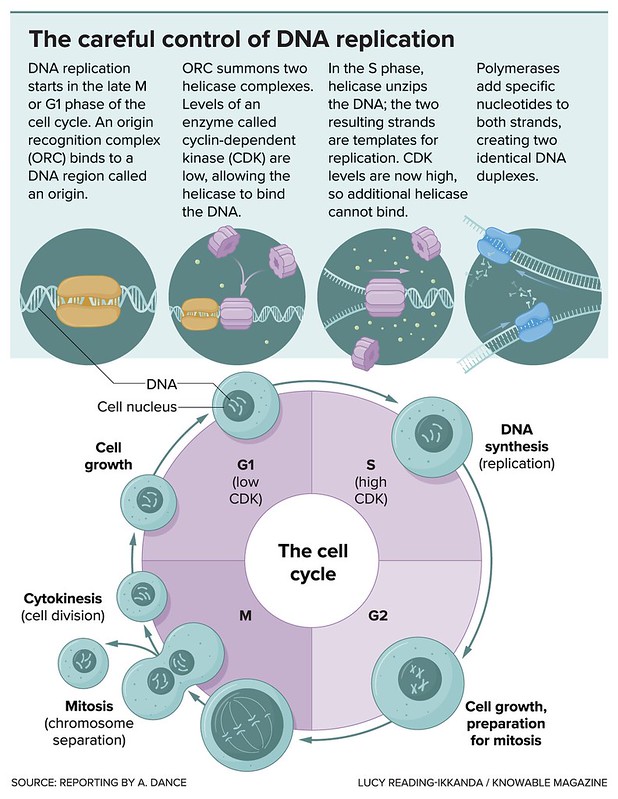The study of mitosis, the process by which cells divide, has had a profound impact on scientists’ understanding of cancer. Cancer is caused by abnormal cell division, which can be triggered by a number of factors, including genetic mutations.
By studying mitosis, scientists have been able to identify the key genes and proteins involved in this process, and this knowledge has led to the development of new drugs and treatments for cancer.
The study of mitosis has allowed scientists to gain a greater understanding of how cancer cells develop and grow. By understanding the process by which normal cells divide, researchers have been able to identify key differences between cancerous and healthy cells. This knowledge has led to the development of more effective treatments for cancer, as well as a better understanding of how the disease progresses.
Additionally, the study of mitosis has helped scientists to better understand the role that genetics plays in the development of cancer.
It is Crucial That the Process of Mitosis is Error Free. This is Because Otherwise Healthy Cells Can
It is crucial that the process of mitosis is error-free. This is because otherwise healthy cells can become cancerous. Cancerous cells are those that have undergone a mutation, or change, in their DNA.
These changes can be caused by errors in replication, which is why it’s so important that mitosis is accurate. Cancerous cells grow and divide out of control, crowding out healthy cells and eventually causing illness and death. While some cancerous growths are benign, or not harmful, others are malignant, meaning they invade nearby tissue and spread to other parts of the body through the bloodstream or lymphatic system.
Metastatic cancer is especially dangerous because it can establish new tumors in distant organs, making treatment difficult. There are many types of cancer, but all share one common feature: uncontrolled cell growth. To understand how this happens, we must first look at how normal cell growth is regulated.
Healthy cells grow and divide in a controlled way to form new cells as needed by the body. This process is carefully regulated by the cell cycle, which consists of two phases: interphase and mitosis (or M phase). Interphase is the longest phase of the cell cycle during which the cell grows and copies its DNA in preparation for division.
During mitosis, the chromosomes line up in the middle of the cell and then separate into two identical sets that are moved into new nuclei at opposite ends of the cell. Finally, the cell membrane pinches off to produce two genetically identical daughter cells. Each daughter cell then enters interphase to begin its own journey through the cell cycle.
How Does Interphase Prepare Cells for Mitosis?
Interphase is the first stage of the cell cycle, during which the cell grows and performs its normal functions. Interphase is followed by mitosis, during which the cell divides into two daughter cells. During interphase, the cell grows and copies its DNA.
This prepares the cell for mitosis when the DNA will be divided into two equal parts. The cell also makes proteins and other molecules that are needed for mitosis.
The Cell Cycle (and Cancer) [Updated]
How Does Mitosis Affect Cancer?
Mitosis is a process of cell division that results in the formation of two genetically identical daughter cells. Cancer arises when cells within the body divide uncontrollably. The uncontrolled cell division characteristic of cancer can be attributed to abnormal mitosis.
In order for mitosis to occur, the chromosomes within the cell must first replicate. Once replicated, the chromosomes are moved to opposite sides of the cell and pulled apart by special proteins called microtubules. The next step is cytokinesis, which is when the cytoplasm of the cell splits into two and forms two new cells.
Cancerous cells often have abnormalities in their mitotic process. One common abnormality is chromosomal instability, which means that the chromosomes are not correctly replicated or segregated during mitosis. This leads to daughter cells with abnormal chromosome numbers, which can lead to further genetic abnormalities and ultimately result in uncontrolled cell growth.
Another way that cancer can arise from abnormal mitosis is through something called genomic instability. This occurs when there are changes in the DNA sequence of genes that control cell proliferation. These changes can cause genes to be turned on or off inappropriately, leading to unchecked cell growth.
How Has the Study of Mitosis Affected Scientists Brainly?
The study of mitosis has had a profound effect on scientists’ understanding of the brain. By understanding how cells divide and grow, scientists have been able to develop treatments for conditions like cancer and Alzheimer’s disease. Additionally, the study of mitosis has helped scientists to better understand how the brain develops and functions.

Credit: brainly.com
How Has the Study of Mitosis Affected Scientists’ Knowledge of Cancer Brainly
Cancer is a leading cause of death worldwide, and scientists are constantly trying to find new ways to prevent and treat the disease. One area of research that has been particularly fruitful is the study of mitosis, the process by which cells divide.
Mitosis is a complex process, and understanding it in detail has helped scientists to develop new cancer treatments.
For example, drugs that target specific proteins involved in mitosis can kill cancer cells while leaving healthy cells unharmed.
The study of mitosis has also led to a better understanding of how cancer cells differ from normal cells. This knowledge is helping scientists to develop more targeted therapies that can specifically target cancer cells without harming healthy ones.
Overall, the study of mitosis has had a major impact on our understanding of cancer and has led to significant progress in the development of new treatments.
Why is It Important for Cancer Researchers to Understand Mitosis?
Cancer researchers need to understand mitosis in order to develop treatments that can target cancer cells specifically. Mitosis is the process by which cells divide and replicate themselves. Cancer cells go through mitosis at a much faster rate than normal, healthy cells.
This means that targeting treatments for cancer cells that interfere with their ability to divide could be an effective way of slowing down or stopping the growth of a tumor. Additionally, understanding how mitosis works could help researchers develop targeted therapies that kill cancer cells without harming healthy cells.
Does Mitosis Help With Cancer?
Cancer is a disease caused by the uncontrolled growth of cells. The main difference between cancer cells and normal cells is that cancer cells divide uncontrollably. Mitosis is the process of cell division, so you might think that mitosis would help with cancer.
However, this is not the case.
While mitosis does allow for the growth of tumors, it also helps to keep them from spreading. When a tumor grows too large, it can break apart and spread to other parts of the body through a process called metastasis.
If cancer cells were able to divide uncontrollably during mitosis, this could lead to more aggressive and dangerous tumors that are more likely to metastasize.
So while mitosis is necessary for the growth of cancerous tumors, it actually helps to keep them in check and prevents them from becoming even more dangerous.
Which Correctly Describes Crossing Over?
crossing over: the process during meiosis in which homologous chromosomes pair up and exchange genetic information. This exchange of information results in new combinations of alleles, which can lead to new traits.
What is the End Result of Meiosis?
Meiosis is a process that reduces the chromosome number by half, resulting in four haploid cells. Haploid cells contain only one copy of each chromosome, while diploid cells contain two copies. Meiosis results in the production of gametes, which are eggs and sperm.
The purpose of meiosis is to create variation in the genetic material so that when gametes fuse during fertilization, they will produce off spring with a unique combination of genes. During meiosis I, homologous chromosomes pair up and exchange bits of DNA, a process called crossing over. This creates new combinations of genes on each chromosome.
Then, the chromosomes line up in pairs at the equator of the cell and are pulled apart by spindle fibers to opposite sides of the cell. This separation is random, so each cell ends up with a different combination of chromosomes. Finally, the cell divides into two daughter cells, each with half the number of chromosomes as the original cell.
Meiosis II is similar to mitosis in that it involves replication and division of the chromatids (two copies of each chromosome), but there is no crossing over or random separation involved. As a result, all four daughter cells end up with exactly the same combination of chromosomes as each other and as the parent cell from which they came. These genetically identical daughter cells are called sister chromatids.
What is the Step That is Labeled D?
When you are trying to quit smoking, there are a lot of different things that you need to do in order to be successful. One of the most important steps is labeled “D,” which stands for “denial.” This step is important because it helps you to recognize that you have a problem and that you need to do something about it.
Once you have recognized your problem, you can start working on solving it.
If you are like most smokers, then you probably deny that you have a problem. You may think that smoking is no big deal and that you can quit anytime you want.
However, this is not true. Smoking is a very addictive habit and it is very hard to break free from it without help.
During the denial stage, it is important to start gathering information about smoking and its effects on your health.
This information will help you to realize just how harmful smoking really is. Once you understand the risks involved with smoking, it will be easier for you to make the decision to quit.
There are many resources available to help you during the denial stage of quitting smoking.
You can talk to your doctor or look online for information about quitting smoking. There are also support groups available where people who are trying to quit can share their experiences and offer support to each other.
Which Correctly Describes Sister Chromatids
Sister chromatids are two genetically identical copies of a chromosome that are joined together at the centromere. During mitosis, sister chromatids separate and move to opposite sides of the cell. After DNA replication, each chromosome consists of two sister chromatids.
Which Best Describes the Processes of Mitosis And Meiosis?
Mitosis and meiosis are two processes that cells use to divide. Mitosis is used to create two identical copies of a cell, while meiosis creates four genetically diverse cells. Both processes are necessary for the continuation of life.
Mitosis begins with a single cell and results in two identical daughter cells. The first step of mitosis is called prophase. During prophase, the chromosomes start to condense and become visible.
The next step, metaphase, is when the chromosomes line up in the middle of the cell. Anaphase is when the chromosomes are pulled apart by spindle fibers and move to opposite sides of the cell. Finally, telophase is when the chromatids reach their destination, and a new nuclear membrane forms around each set of chromatids.
cytokinesis then occurs, which completes the process by dividing the cytoplasm evenly between the two new cells. Meiosis also starts with one cell, but instead of resulting in two identical daughter cells like mitosis does, meiosis results in four genetically diverse daughter cells. Meiosis goes through similar steps as mitosis does during prophase I and II –chromosomes condense and line up in the middle of the cell– but there are some key differences as well.
One difference is that during metaphase I, homologous chromosome pairs line up next to each other rather than sister chromatids like in mitosis; this allows for genetic recombination to occur between these chromosome pairs. Another difference occurs during anaphase I where homologous chromosome pairs are separated from each other rather than sister chromatids; this ensures that each new cell will have a unique combination of genes.
Frequently Asked Questions:
Why would understanding mitosis help researchers better understand cancer?
Understanding mitosis is crucial for cancer research because cancer often involves uncontrolled cell division. By studying the mechanisms of mitosis, researchers can identify abnormalities in cell cycle regulation, detect mutations, and develop targeted therapies to intervene in the uncontrolled growth of cancer cells.
How do cancer treatments affect mitosis?
Cancer treatments, such as chemotherapy and radiation therapy, often target rapidly dividing cells, including those undergoing mitosis. These treatments aim to disrupt the cell cycle and prevent further proliferation of cancer cells. However, they may also affect normal, healthy cells that divide rapidly, leading to side effects. Newer targeted therapies aim to specifically inhibit the abnormal signaling pathways involved in cancer cell division, minimizing damage to healthy cells.
Why is it important for scientists to study mitosis?
Studying mitosis is essential for scientists because it provides insights into the fundamental process of cell division. Understanding mitosis helps unravel the mechanisms that control growth, development, and tissue repair. It is particularly crucial in the context of diseases like cancer, where aberrations in mitotic control lead to uncontrolled cell proliferation. Insights from mitosis research inform medical interventions, drug development, and therapeutic strategies aimed at addressing various health conditions, including cancer.
How has the Study of Mitosis Contributed to Understanding Nanotechnology in Cancer Research?
The study of mitosis has greatly contributed to the understanding of the relation between chemical science and nanotechnology in cancer research. By understanding the intricate processes of cell division, scientists can develop targeted nanotechnology-based therapies that specifically disrupt cancer cell growth while minimizing damage to healthy cells.
Conclusion
The study of mitosis has helped scientists to better understand how cancer cells develop and grow. By understanding the process of cell division, scientists have been able to identify potential targets for new cancer therapies. Additionally, the study of mitosis has led to the development of new diagnostic tools that can help detect cancer at an early stage.
Related Articles:
Insect Invasion: Threat to Utah’s Fir Forests
 Dr Ahsanur Rahman, PHD
Dr Ahsanur Rahman, PHD
UK Forests Collapse Imminent: Act Now Against Climate!
 Dr Ahsanur Rahman, PHD
Dr Ahsanur Rahman, PHD
Lightning Strikes Threat: Boreal Fires Jeopardize Carbon
 Dr Ahsanur Rahman, PHD
Dr Ahsanur Rahman, PHD

![Scientists’ Knowledge of Cancer]](https://sarpo.net/wp-content/uploads/2022/12/Can-Japanese-Maple-Trees-Be-Planted-in-Full-Sun-2.png)








